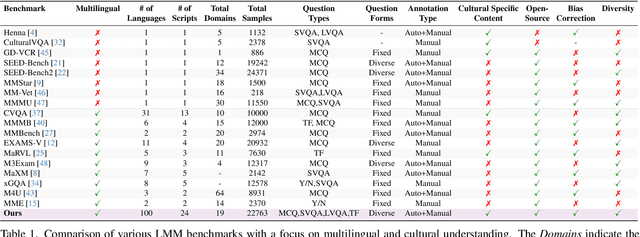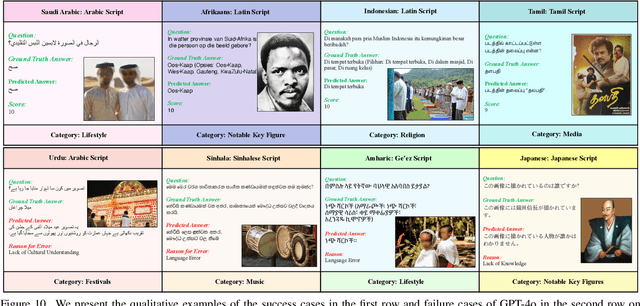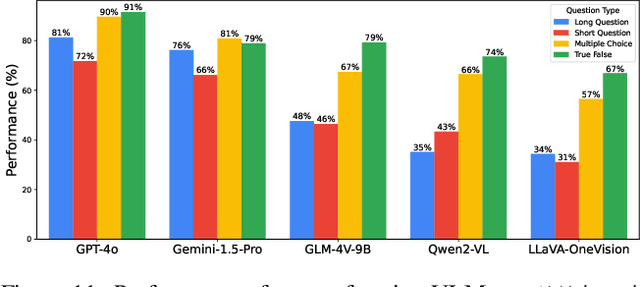Fahad Khan
CNR-ILC
VideoMathQA: Benchmarking Mathematical Reasoning via Multimodal Understanding in Videos
Jun 05, 2025Abstract:Mathematical reasoning in real-world video settings presents a fundamentally different challenge than in static images or text. It requires interpreting fine-grained visual information, accurately reading handwritten or digital text, and integrating spoken cues, often dispersed non-linearly over time. In such multimodal contexts, success hinges not just on perception, but on selectively identifying and integrating the right contextual details from a rich and noisy stream of content. To this end, we introduce VideoMathQA, a benchmark designed to evaluate whether models can perform such temporally extended cross-modal reasoning on videos. The benchmark spans 10 diverse mathematical domains, covering videos ranging from 10 seconds to over 1 hour. It requires models to interpret structured visual content, understand instructional narratives, and jointly ground concepts across visual, audio, and textual modalities. We employ graduate-level experts to ensure high quality, totaling over $920$ man-hours of annotation. To reflect real-world scenarios, questions are designed around three core reasoning challenges: direct problem solving, where answers are grounded in the presented question; conceptual transfer, which requires applying learned methods to new problems; and deep instructional comprehension, involving multi-step reasoning over extended explanations and partially worked-out solutions. Each question includes multi-step reasoning annotations, enabling fine-grained diagnosis of model capabilities. Through this benchmark, we highlight the limitations of existing approaches and establish a systematic evaluation framework for models that must reason, rather than merely perceive, across temporally extended and modality-rich mathematical problem settings. Our benchmark and evaluation code are available at: https://mbzuai-oryx.github.io/VideoMathQA
How Good is my Histopathology Vision-Language Foundation Model? A Holistic Benchmark
Mar 17, 2025



Abstract:Recently, histopathology vision-language foundation models (VLMs) have gained popularity due to their enhanced performance and generalizability across different downstream tasks. However, most existing histopathology benchmarks are either unimodal or limited in terms of diversity of clinical tasks, organs, and acquisition instruments, as well as their partial availability to the public due to patient data privacy. As a consequence, there is a lack of comprehensive evaluation of existing histopathology VLMs on a unified benchmark setting that better reflects a wide range of clinical scenarios. To address this gap, we introduce HistoVL, a fully open-source comprehensive benchmark comprising images acquired using up to 11 various acquisition tools that are paired with specifically crafted captions by incorporating class names and diverse pathology descriptions. Our Histo-VL includes 26 organs, 31 cancer types, and a wide variety of tissue obtained from 14 heterogeneous patient cohorts, totaling more than 5 million patches obtained from over 41K WSIs viewed under various magnification levels. We systematically evaluate existing histopathology VLMs on Histo-VL to simulate diverse tasks performed by experts in real-world clinical scenarios. Our analysis reveals interesting findings, including large sensitivity of most existing histopathology VLMs to textual changes with a drop in balanced accuracy of up to 25% in tasks such as Metastasis detection, low robustness to adversarial attacks, as well as improper calibration of models evident through high ECE values and low model prediction confidence, all of which can affect their clinical implementation.
LLMVoX: Autoregressive Streaming Text-to-Speech Model for Any LLM
Mar 06, 2025Abstract:Recent advancements in speech-to-speech dialogue systems leverage LLMs for multimodal interactions, yet they remain hindered by fine-tuning requirements, high computational overhead, and text-speech misalignment. Existing speech-enabled LLMs often degrade conversational quality by modifying the LLM, thereby compromising its linguistic capabilities. In contrast, we propose LLMVoX, a lightweight 30M-parameter, LLM-agnostic, autoregressive streaming TTS system that generates high-quality speech with low latency, while fully preserving the capabilities of the base LLM. Our approach achieves a significantly lower Word Error Rate compared to speech-enabled LLMs, while operating at comparable latency and UTMOS score. By decoupling speech synthesis from LLM processing via a multi-queue token streaming system, LLMVoX supports seamless, infinite-length dialogues. Its plug-and-play design also facilitates extension to various tasks with different backbones. Furthermore, LLMVoX generalizes to new languages with only dataset adaptation, attaining a low Character Error Rate on an Arabic speech task. Additionally, we have integrated LLMVoX with a Vision-Language Model to create an omni-model with speech, text, and vision capabilities, without requiring additional multimodal training. Our code base and project page is available at https://mbzuai-oryx.github.io/LLMVoX .
KITAB-Bench: A Comprehensive Multi-Domain Benchmark for Arabic OCR and Document Understanding
Feb 20, 2025Abstract:With the growing adoption of Retrieval-Augmented Generation (RAG) in document processing, robust text recognition has become increasingly critical for knowledge extraction. While OCR (Optical Character Recognition) for English and other languages benefits from large datasets and well-established benchmarks, Arabic OCR faces unique challenges due to its cursive script, right-to-left text flow, and complex typographic and calligraphic features. We present KITAB-Bench, a comprehensive Arabic OCR benchmark that fills the gaps in current evaluation systems. Our benchmark comprises 8,809 samples across 9 major domains and 36 sub-domains, encompassing diverse document types including handwritten text, structured tables, and specialized coverage of 21 chart types for business intelligence. Our findings show that modern vision-language models (such as GPT-4, Gemini, and Qwen) outperform traditional OCR approaches (like EasyOCR, PaddleOCR, and Surya) by an average of 60% in Character Error Rate (CER). Furthermore, we highlight significant limitations of current Arabic OCR models, particularly in PDF-to-Markdown conversion, where the best model Gemini-2.0-Flash achieves only 65% accuracy. This underscores the challenges in accurately recognizing Arabic text, including issues with complex fonts, numeral recognition errors, word elongation, and table structure detection. This work establishes a rigorous evaluation framework that can drive improvements in Arabic document analysis methods and bridge the performance gap with English OCR technologies.
Robust-LLaVA: On the Effectiveness of Large-Scale Robust Image Encoders for Multi-modal Large Language Models
Feb 03, 2025



Abstract:Multi-modal Large Language Models (MLLMs) excel in vision-language tasks but remain vulnerable to visual adversarial perturbations that can induce hallucinations, manipulate responses, or bypass safety mechanisms. Existing methods seek to mitigate these risks by applying constrained adversarial fine-tuning to CLIP vision encoders on ImageNet-scale data, ensuring their generalization ability is preserved. However, this limited adversarial training restricts robustness and broader generalization. In this work, we explore an alternative approach of leveraging existing vision classification models that have been adversarially pre-trained on large-scale data. Our analysis reveals two principal contributions: (1) the extensive scale and diversity of adversarial pre-training enables these models to demonstrate superior robustness against diverse adversarial threats, ranging from imperceptible perturbations to advanced jailbreaking attempts, without requiring additional adversarial training, and (2) end-to-end MLLM integration with these robust models facilitates enhanced adaptation of language components to robust visual features, outperforming existing plug-and-play methodologies on complex reasoning tasks. Through systematic evaluation across visual question-answering, image captioning, and jail-break attacks, we demonstrate that MLLMs trained with these robust models achieve superior adversarial robustness while maintaining favorable clean performance. Our framework achieves 2x and 1.5x average robustness gains in captioning and VQA tasks, respectively, and delivers over 10% improvement against jailbreak attacks. Code and pretrained models will be available at https://github.com/HashmatShadab/Robust-LLaVA.
BiMediX2: Bio-Medical EXpert LMM for Diverse Medical Modalities
Dec 10, 2024



Abstract:This paper introduces BiMediX2, a bilingual (Arabic-English) Bio-Medical EXpert Large Multimodal Model (LMM) with a unified architecture that integrates text and visual modalities, enabling advanced image understanding and medical applications. BiMediX2 leverages the Llama3.1 architecture and integrates text and visual capabilities to facilitate seamless interactions in both English and Arabic, supporting text-based inputs and multi-turn conversations involving medical images. The model is trained on an extensive bilingual healthcare dataset consisting of 1.6M samples of diverse medical interactions for both text and image modalities, mixed in Arabic and English. We also propose the first bilingual GPT-4o based medical LMM benchmark named BiMed-MBench. BiMediX2 is benchmarked on both text-based and image-based tasks, achieving state-of-the-art performance across several medical benchmarks. It outperforms recent state-of-the-art models in medical LLM evaluation benchmarks. Our model also sets a new benchmark in multimodal medical evaluations with over 9% improvement in English and over 20% in Arabic evaluations. Additionally, it surpasses GPT-4 by around 9% in UPHILL factual accuracy evaluations and excels in various medical Visual Question Answering, Report Generation, and Report Summarization tasks. The project page including source code and the trained model, is available at https://github.com/mbzuai-oryx/BiMediX2.
All Languages Matter: Evaluating LMMs on Culturally Diverse 100 Languages
Nov 25, 2024



Abstract:Existing Large Multimodal Models (LMMs) generally focus on only a few regions and languages. As LMMs continue to improve, it is increasingly important to ensure they understand cultural contexts, respect local sensitivities, and support low-resource languages, all while effectively integrating corresponding visual cues. In pursuit of culturally diverse global multimodal models, our proposed All Languages Matter Benchmark (ALM-bench) represents the largest and most comprehensive effort to date for evaluating LMMs across 100 languages. ALM-bench challenges existing models by testing their ability to understand and reason about culturally diverse images paired with text in various languages, including many low-resource languages traditionally underrepresented in LMM research. The benchmark offers a robust and nuanced evaluation framework featuring various question formats, including true/false, multiple choice, and open-ended questions, which are further divided into short and long-answer categories. ALM-bench design ensures a comprehensive assessment of a model's ability to handle varied levels of difficulty in visual and linguistic reasoning. To capture the rich tapestry of global cultures, ALM-bench carefully curates content from 13 distinct cultural aspects, ranging from traditions and rituals to famous personalities and celebrations. Through this, ALM-bench not only provides a rigorous testing ground for state-of-the-art open and closed-source LMMs but also highlights the importance of cultural and linguistic inclusivity, encouraging the development of models that can serve diverse global populations effectively. Our benchmark is publicly available.
AgriCLIP: Adapting CLIP for Agriculture and Livestock via Domain-Specialized Cross-Model Alignment
Oct 02, 2024Abstract:Capitalizing on vast amount of image-text data, large-scale vision-language pre-training has demonstrated remarkable zero-shot capabilities and has been utilized in several applications. However, models trained on general everyday web-crawled data often exhibit sub-optimal performance for specialized domains, likely due to domain shift. Recent works have tackled this problem for some domains (e.g., healthcare) by constructing domain-specialized image-text data. However, constructing a dedicated large-scale image-text dataset for sustainable area of agriculture and livestock is still open to research. Further, this domain desires fine-grained feature learning due to the subtle nature of the downstream tasks (e.g, nutrient deficiency detection, livestock breed classification). To address this we present AgriCLIP, a vision-language foundational model dedicated to the domain of agriculture and livestock. First, we propose a large-scale dataset, named ALive, that leverages customized prompt generation strategy to overcome the scarcity of expert annotations. Our ALive dataset covers crops, livestock, and fishery, with around 600,000 image-text pairs. Second, we propose a training pipeline that integrates both contrastive and self-supervised learning to learn both global semantic and local fine-grained domain-specialized features. Experiments on diverse set of 20 downstream tasks demonstrate the effectiveness of AgriCLIP framework, achieving an absolute gain of 7.8\% in terms of average zero-shot classification accuracy, over the standard CLIP adaptation via domain-specialized ALive dataset. Our ALive dataset and code can be accessible at \href{https://github.com/umair1221/AgriCLIP/tree/main}{Github}.
VideoGPT+: Integrating Image and Video Encoders for Enhanced Video Understanding
Jun 13, 2024



Abstract:Building on the advances of language models, Large Multimodal Models (LMMs) have contributed significant improvements in video understanding. While the current video LMMs utilize advanced Large Language Models (LLMs), they rely on either image or video encoders to process visual inputs, each of which has its own limitations. Image encoders excel at capturing rich spatial details from frame sequences but lack explicit temporal context, which can be important in videos with intricate action sequences. On the other hand, video encoders provide temporal context but are often limited by computational constraints that lead to processing only sparse frames at lower resolutions, resulting in reduced contextual and spatial understanding. To this end, we introduce VideoGPT+, which combines the complementary benefits of the image encoder (for detailed spatial understanding) and the video encoder (for global temporal context modeling). The model processes videos by dividing them into smaller segments and applies an adaptive pooling strategy on features extracted by both image and video encoders. Our architecture showcases improved performance across multiple video benchmarks, including VCGBench, MVBench and Zero-shot question-answering. Further, we develop 112K video-instruction set using a novel semi-automatic annotation pipeline which further improves the model performance. Additionally, to comprehensively evaluate video LMMs, we present VCGBench-Diverse, covering 18 broad video categories such as lifestyle, sports, science, gaming, and surveillance videos. This benchmark with 4,354 question-answer pairs evaluates the generalization of existing LMMs on dense video captioning, spatial and temporal understanding, and complex reasoning, ensuring comprehensive assessment across diverse video types and dynamics. Code: https://github.com/mbzuai-oryx/VideoGPT-plus.
On the Design of Human-Robot Collaboration Gestures
Feb 29, 2024
Abstract:Effective communication between humans and collaborative robots is essential for seamless Human-Robot Collaboration (HRC). In noisy industrial settings, nonverbal communication, such as gestures, plays a key role in conveying commands and information to robots efficiently. While existing literature has thoroughly examined gesture recognition and robots' responses to these gestures, there is a notable gap in exploring the design of these gestures. The criteria for creating efficient HRC gestures are scattered across numerous studies. This paper surveys the design principles of HRC gestures, as contained in the literature, aiming to consolidate a set of criteria for HRC gesture design. It also examines the methods used for designing and evaluating HRC gestures to highlight research gaps and present directions for future research in this area.
 Add to Chrome
Add to Chrome Add to Firefox
Add to Firefox Add to Edge
Add to Edge